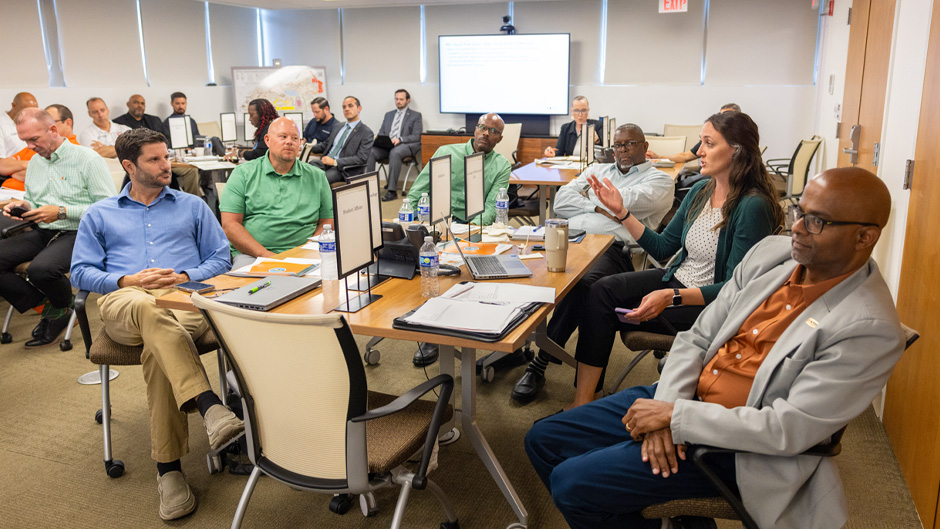More than 150 staff members from the University of Miami participated in a recent simulated exercise to coordinate how the institution’s most critical departments would respond to a hurricane.
Scheduled just before the 2025 hurricane season begins, the May 30 event was a timely affair. And unlike other recent exercises, which focused more on preparations and actions during a hurricane, this simulation centered on the aftermath of a fictional Category 2 storm called Hurricane Cleo that made a direct hit to the greater Miami area. The exercise was organized by the University’s Office of Emergency Management and UHealth Emergency Management, which together lead University planning for hurricanes and other types of large-scale incidents. Their top priority: keeping students, faculty and staff members, as well as UHealth patients, safe from harm.
“Thank you all for really embracing and working through these challenging and critical issues,” Matt Shpiner, executive director of emergency management for the University, told participants at the conclusion of the exercise. “Everyone embraced what was a complex and difficult scenario presented in this exercise, and as a result, we are better prepared and will recover quicker whenever we face the next threat.”
As part of the simulation, teams from the University’s three campuses—the Coral Gables Campus, Medical Campus, and the Marine Campus on Virginia Key—participated in person at the Unified Operations Center in Coral Gables and through videoconferencing software and listened to a briefing about the storm and its landfall. This included representatives from divisions and departments from across the institution, along with partners from the City of Coral Gables.
At the Medical Campus, three hospital command centers were set up at Bascom Palmer Eye Institute, Sylvester Comprehensive Cancer Center, and the Medical Coordination Center (MCC), which communicates with the rest of the University’s campuses and clinics, and city and county emergency operations centers throughout a natural disaster. These command centers—including one at UHealth Tower—are typically set up three days before tropical storm force winds arrive, said Vincent Torres, executive director of emergency management for the University of Miami Health System and Miller School of Medicine. The exercise also helped leadership teams test new communication devices like radios and satellite technology that they may need to use before, during, and after a storm, Torres added.
“Our goal is to get UHealth hospitals and clinics back to normal operations as fast as possible following a hurricane. But the key is we do it safely,” said Torres, who is also associate director of disaster management at the Miller School’s Global Institute for Community Health and Development. “These exercises serve to improve our response and management of emergency and disaster incidents to ensure we are here to serve our patients, students, and employees.”
Fortunately, the fictional storm made landfall around 2 a.m., with some flooding but no major structural damage to campus buildings. However, the additional water on campus presented challenges for navigating the University and its residential colleges and prompted a delay to resuming in-person classes. In addition, University-led debris clearance crews worked in unison with City of Coral Gables teams to remove debris from the roads around campus, while housing, information technology, and facilities officials faced power and generator outages as they assessed the damage.
In addition, leadership worked across divisions to help create recovery update messages for students, faculty and staff members through a fictional Hurricane Alert website, and emergency text messages.
All told, about 48 hours after Cleo, power was mostly restored to campus, and the majority of students were able to return to their on-campus residential colleges. While classes had to be delayed, they would progressively resume according to plan, with a potential for virtual learning before in-person instruction resumed. Overall, Shpiner and his team considered the exercise a success and a needed review of existing plans for campus leaders.
“This helps us test our plans to make sure we are prepared to respond to any type of emergency, and in this case, hurricanes,” said Anna Simko, the University’s emergency preparedness manager. “We do a hurricane exercise every year, but this was the first time we had multiple campuses involved, so it was unique and allowed us to really test our resources.”

